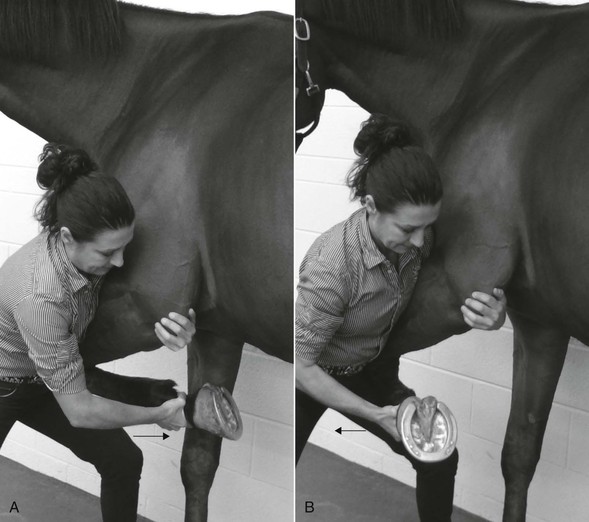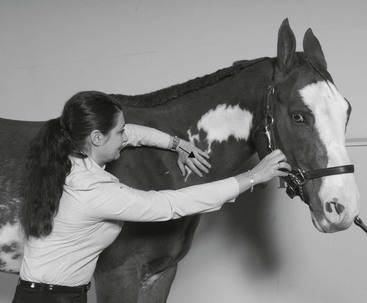Narelle Colleen Stubbs
Physical Therapy and Rehabilitation
Equine physical therapy (PT) is used to optimize performance and prevent injury in the sport horse and to aid rehabilitation after injury, surgical procedures, and neurologic or other medical conditions. Evidence-based medicine, clinical reports, and comparative human sports sciences form the basis of equine PT and rehabilitation, with a focus on tissue healing, biomechanics, and neuromotor control.
It is not possible to prescribe a standard PT treatment that is appropriate for every horse with a given type of lesion or pathoanatomic diagnosis. Treatments should be individually tailored to each horse, taking into account the whole animal, its type of equitation, short- and long-term performance goals, and overall prognosis for recovery. Treatments should complement medical management to promote tissue healing, assist normal physiologic processes, and restore previous sport potential. Equine PT includes manual therapies, electrotherapy, functional retraining, and therapeutic exercise-based treatments, along with education and ongoing owner-managed procedures.
Rehabilitation of the horse requires a diagnosis of the underlying condition by a veterinarian, a thorough objective functional assessment of the horse, and consultation with other health professionals. The knowledge and skills unique to these professions are focused on determining the movement potential of the horse, with all information and confounding factors being incorporated to establish an accurate functional diagnosis, problem list, management plan, and goals. During rehabilitation, reliable objective measures are necessary to assess the treatment response. Rehabilitation should begin as soon as possible after injury and should be used in collaboration with analgesic and antiinflammatory treatments. In some cases, PT may be used before or immediately after surgery. For this reason, rehabilitation must be managed by a multidisciplinary team.
No single chapter can describe all aspects of equine rehabilitation; this chapter presents fundamental evidence-based concepts of PT and rehabilitation focusing on manual therapies, electrotherapy, and exercise-based treatments. A recent textbook (McGowan et al, 2007) describes the foundations of animal physiotherapy and provides a good reference with regard to evidence-based rehabilitation. That and other useful references are provided in the Suggested Readings.
Clinical and Client Demand for Physical Therapy and Rehabilitation
Musculoskeletal injuries are the predominant cause of loss of use and death of sport horses, with flexor tendon and suspensory ligament injuries being most frequently reported in the horses that perform at high speed and over jumps. Veterinary management, rehabilitation, and PT can be vital in allowing horses performing in dressage, show jumping, and eventing to successfully compete despite chronic low-grade injury. Although suspensory desmitis is common in both dressage horses and show jumpers, four medal winners in the Sydney Olympics had this diagnosis. In eventing horses, tendon and ligament lesions occur with even greater frequency. When these horses are competing in events requiring adherence to the rules of the Fédération Equestre Internationale with respect to nonpharmaceutical treatments (see Chapter 26), careful management and use of rehabilitation and PT techniques are vital.
Back pain in horses can be a major cause of alterations in gait and performance, but rehabilitation strategies are widely recognized as being of great clinical use. In Thoroughbred racehorses, lesions of the caudal thoracolumbar portion of the spine and the pelvic regions are often underdiagnosed, and a similar finding of underdiagnosis has been reported in dressage horses. The fact that owners request complementary therapies when their horses have back pain more frequently than they request veterinary care reflects the demand for multidisciplinary treatments. For long-term management of chronic and recurrent back pain, PT in conjunction with medical management is useful for horses, as is true for humans with back pain.
Manual Therapy
When using manual therapy techniques, the therapist applies very specific passive or actively assisted movements to the horse to manage or alter pain and dysfunction of the articular, neural, and muscle systems. These techniques, which are based on a wide range of methods and theories related to the intervertebral and peripheral joint complexes, myofascia, and the neuromuscular system, include passive accessory and physiologic joint mobilization techniques that have been successfully adapted to treat horses. Numerous myofascial and neuromuscular mobilization techniques also can be used, some of which include massage (friction, effleurage, pétrissage, tapôtement, vibrations, and shaking), trigger point therapy, direct and indirect myofascial release, positional release, reflex inhibition techniques, craniosacral therapy, adverse neural tension techniques, and stretching.
To effectively establish a treatment protocol and apply these techniques, it is essential to make an accurate functional observational and palpation assessment of the musculoskeletal and neuromuscular systems to identify the primary and secondary conditions that may be responsible for or contributing to pain and loss of function. The assessment should include a full static and dynamic examination followed by palpation, including specific manual testing and provocation tests. These procedures should determine the regions of altered range of motion, quality of movement, muscle dysfunction, and sites of tissue irritability.
Joint Mobilization
Degenerative joint disease is an example of a common dysfunction in which manual therapy can be successfully applied. Techniques such as passive mobilizations can be applied to the articular system, including the vertebral column and peripheral joints, with complementary soft tissue techniques applied to the associated neuromuscular and fascial tissues. These repeated movement techniques have beneficial effects on the intraarticular, periarticular (joint capsule and ligament), and extraarticular structures (muscle, fascia, and neural tissue), and thus affect the passive and active constraints of the joint complex and primarily assist in pain modulation. Manual therapy produces an initial treatment-specific local hypoalgesia and a sympathetic–excitatory effect that is followed by systemic non–opioid-mediated relief of pain.
Passive mobilizations are applied at a variety of amplitudes and velocities and in various directions that are based on the assessment outcome and biomechanics of the joint complex. It is the author’s experience that manual passive assessment and treatment techniques directed at a joint, soft tissue, or neural structures are well tolerated by the horse when rhythmic motion is applied at a comfortable speed. This may include a high-velocity thrust technique.
Two highly effective mobilization techniques are often used to restore joint motion and reduce pain in the horse. Passive physiologic mobilizations reproduce the forces occurring during voluntary motion around the three axes of motion of the affected joint complex. In contrast, passive accessory movements produce motion that accompanies rotations, which cannot be voluntarily performed by the horse. An example of the application of a combination of these techniques applied to the carpus is shown (Figure 24-1). In the author’s experience, these techniques are best applied in midrange and end-range positions, which is commonly the practice in human PT, rather than only in the neutral standing posture. Clinically this is particularly effective in relation to intersegmental motion in the spine. The practitioner is able to use combined mobilization with movement techniques (described later) or may use an assistant to maintain the desired postures. Direct dorsoventral and lateral passive accessory glides can then be performed manually over the dorsal spinous processes, ribs, and vertebral bodies (in the cervical part of the spine; Figure 24-2) and transverse processes (lumbar spine) in the end-range functional positions.
Soft Tissue Mobilization
Manual therapy techniques directed at the myofascia, tendons, and ligaments aim to normalize tissue irritability, muscle tone, extensibility, length, contractility, strength, and coordination and ultimately to improve motor control. In horses with limb or back pain, muscular dysfunction often arises secondary to underlying bone pathology, but primary muscle atrophy, disease, or injury may also be present: muscle damage caused by a poorly fitting saddle is not uncommon in sport horses.
Following soft tissue injury, dynamic stretching regimens can be implemented to regain and maintain full range of motion during the healing process. These techniques can also be applied to prevent the detrimental effects of immobilization in any horse that is on a restricted exercise regime or confined to the stable. Horses are usually standing during treatment, and for this reason, the stretching procedure is always dynamic and never completely passive. However, “positional release,” which is a form of gentle stretching that is useful for treatment of chronic myofascial restrictions, can be performed with the horse under sedation or anesthetized with some success (see Pusey et al, 2010). The technique is often used only after all other avenues have been exhausted because of anesthetic risk.
Because tissue-stretching techniques used in the horse are never completely passive, “tissue mobilization with movement” may be a more appropriate term for many of the stretching techniques. These are performed either rhythmically or in a sustained manner, dependent on the desired response and effect on the tissues. Examples are provided later in this chapter in the section on “Mobilization With Movement.”
If there is a primary soft tissue lesion in muscle, ligament, or tendon, stretches or active mobilizations with movement exercises in conjunction with other therapies may be appropriate in trying to prevent excessive scar formation and disorientation of fiber alignment in the subacute and chronic phases of healing. With regard to rehabilitation of distal tendon and ligament lesions, it has been widely reported in the human literature that dynamic motor control–based exercises accelerate healing and tensile strength, especially in Achilles’ tendon lesions. In the case of the horse, this means active rest, wherein the horse starts a walking program after the lesion is stabilized. The author also includes unmounted exercises to increase the dynamic core muscle strength. Fibrotic myopathy is a good example of a chronic condition that may benefit from repeated and sustained stretching exercises. The affected limb is manually moved toward the limit of available range of motion to stress the desired soft tissue structures.





